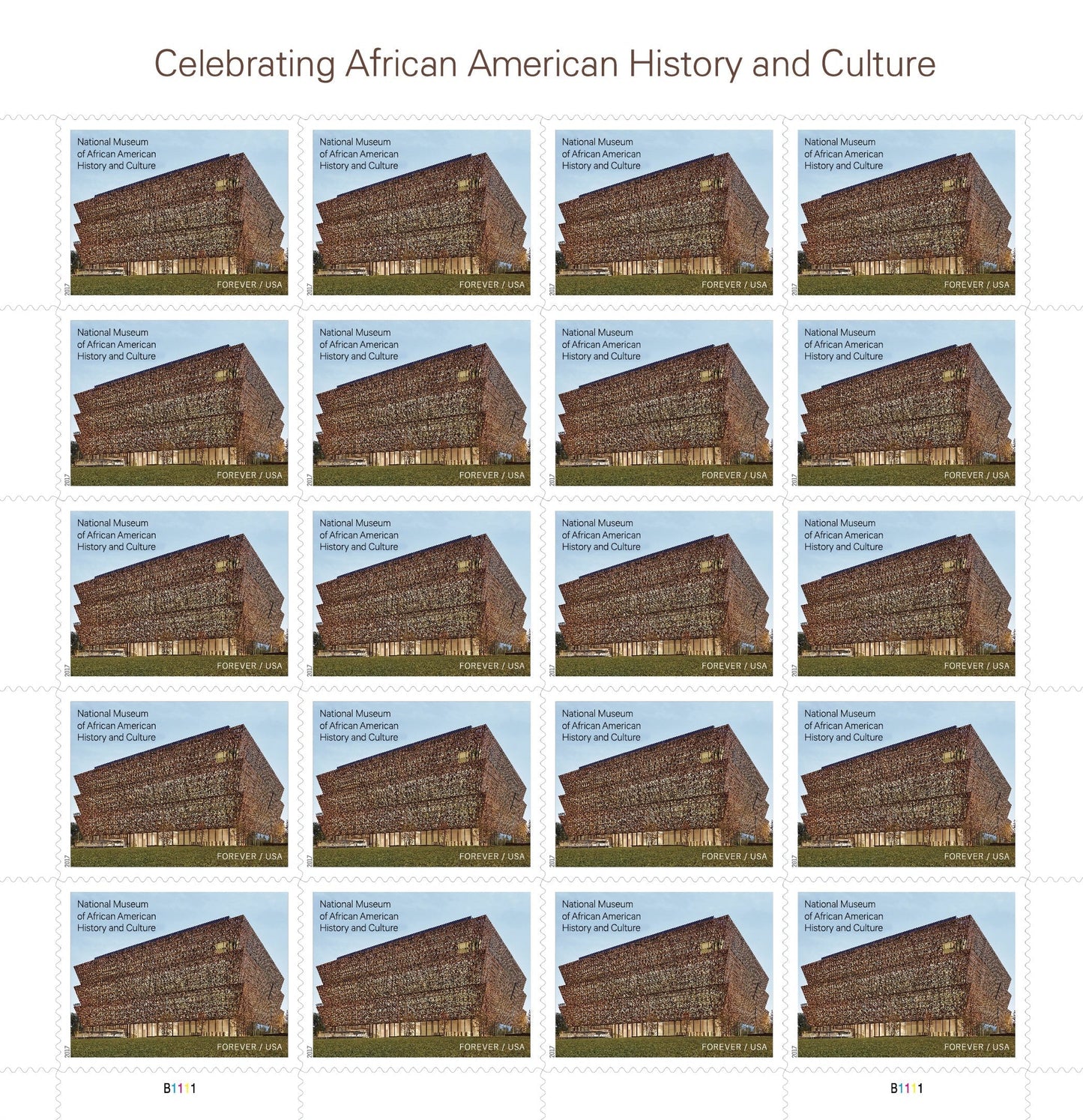Stamps Co LLC
Celebrating African American History and Culture Forever Stamps
Celebrating African American History and Culture Forever Stamps
Couldn't load pickup availability
Explore Forever Stamps Celebrating African American History and Culture
On September 24, 2016, the National Museum of African American History and Culture opened in Washington, DC.
Calls for a museum honoring African American history and culture date back to 1915. That year, a group of African American Union Army veterans met in Washington, DC for a reunion and parade, but were met with discrimination. After that, the group made plans to create a memorial to African American achievements.
After years of efforts, their proposal was received by President Herbert Hoover, who called on Mary Church Terrell, Mary McLeod Bethune, and others to work toward creating a National Memorial Building to African American achievements. However, Congress didn’t award funding and private fundraising failed.
Over the next several decades, new proposals would surface, but none gained major support. Then in 1981, Congress approved the creation of the National Afro-American Museum in Wilberforce, Ohio. However, some still called for a stand-alone museum in Washington, DC. The attention these calls received inspired the Smithsonian to stage an exhibit, “Field to Factory,” which in turn gained further support for the museum idea.
The museum’s supporters repeatedly proposed their idea and finally achieved success in 2003. On November 19, the House passed the National Museum of African American History and Culture Act, providing funds and a location for the museum. The legislation also included funding for other African American museums to help improve their operations and collections.
In 2008, the museum’s council held a competition to design the 350,000-square foot building, which would include three stories below ground and five above. The winning design was in the shape of an upside down pyramid surrounded by bronze elements, inspired by the crowns used in Yoruban culture The building’s groundbreaking ceremony took place on February 22, 2012.
While the building design and construction were underway, the museum’s officials had to create the collection. So, the museum’s curators launched a nationwide campaign asking for donations. In the end, generous and supportive citizens donated a collection of about 40,000 artifacts.
The museum officially opened to the public on September 24, 2016, with President Barack Obama participating in the dedication ceremony. President Obama and the Bonner family, descendants of escaped slave Elijah B. Odom, rang the Freedom Bell to mark the museum’s official opening.
A tour of the museum begins 70 feet below ground level, tracing history from slavery to emancipation. Exhibits include part of a slave ship, shackles, an auction block, bales of cotton, Harriet Tubman’s shawl, and Nat Turner’s bible. The next section features items from the segregation-era, including a “whites only” door, Rosa Parks’ dress, a prison tower, a Ku Klux Klan robe, and a segregated railroad car. There is also a Contemplative Court to reflect on the history inside.
The museum’s upper galleries honor African Americans in art, entertainment, and the military. Exhibits include military medals, Muhammad Ali’s boxing gloves, Jesse Owens’ cleats, Althea Gibson’s racket, Jimi Hendrix’s vest, and Louis Armstrong’s trumpet. Together, these relics celebrate African American’s triumph over adversity.
By the end of its first year, the museum had three million visitors, with an average of 8,000 people every day, double what planners had anticipated.
Understanding Forever Stamps
Forever Stamps are a unique and convenient way to send mail in the United States. They are specially designed so that no matter the increase in postage rates, the Forever Stamp will always cover the cost of a first-class letter. This feature makes them both practical and valuable for collectors. What makes them even more special is that some Forever Stamps celebrate significant cultural moments and individuals, such as the rich history of African Americans in the United States.
The Significance of African American History Forever Stamps
Forever Stamps recognizing African American history highlight the contributions and achievements of influential figures and events. For example, stamps may feature renowned leaders like Frederick Douglass or iconic events such as the Civil Rights Movement. They serve not only as a means to send mail but also as a reminder of the ongoing journey for equality and justice. Collectors and enthusiasts cherish these stamps because they embody powerful stories and lessons from the past.
Collecting Forever Stamps
Many people enjoy collecting Forever Stamps that celebrate African American history because they tell important cultural stories. Collectors appreciate how each stamp can serve as both an artistic piece and a historical artifact. If you're new to stamp collecting, starting with these unique stamps is a meaningful way to learn about African American history and culture. Engaging with these stamps can spark interest in history, making them a great addition to any collection, and ensuring their significance in our postal services endures.
Share


